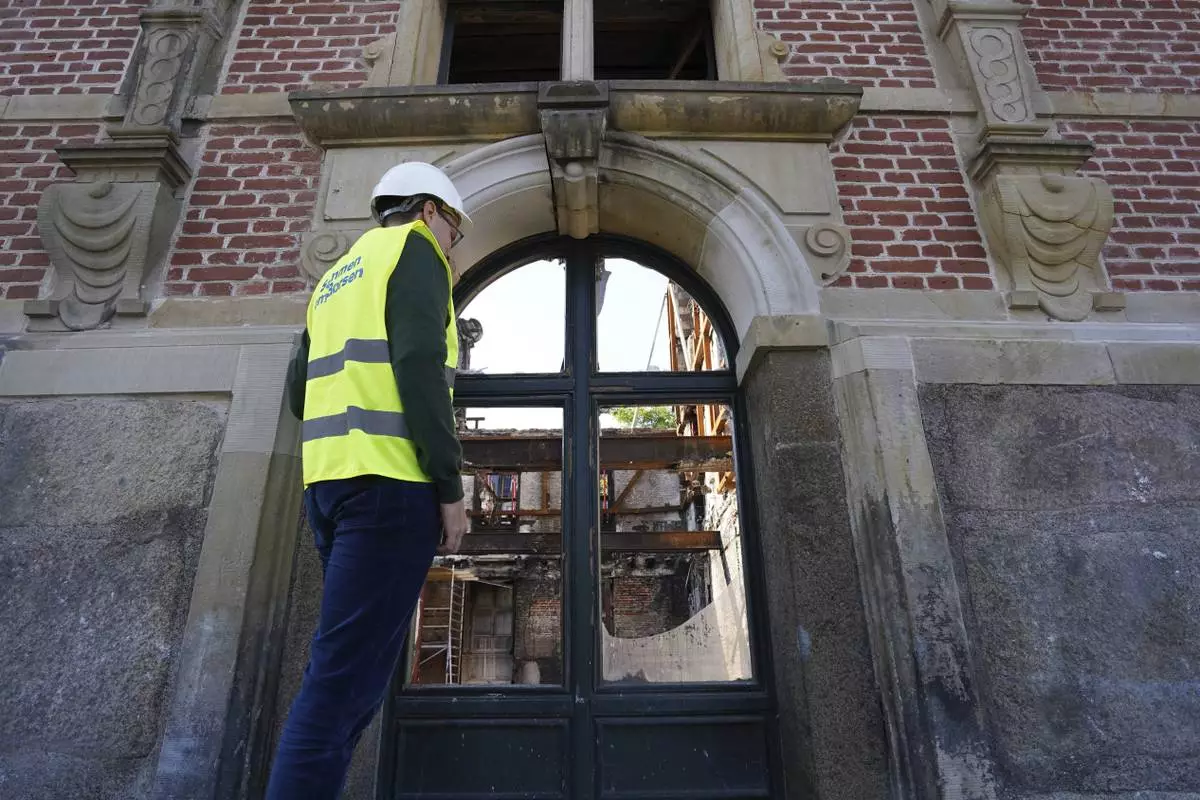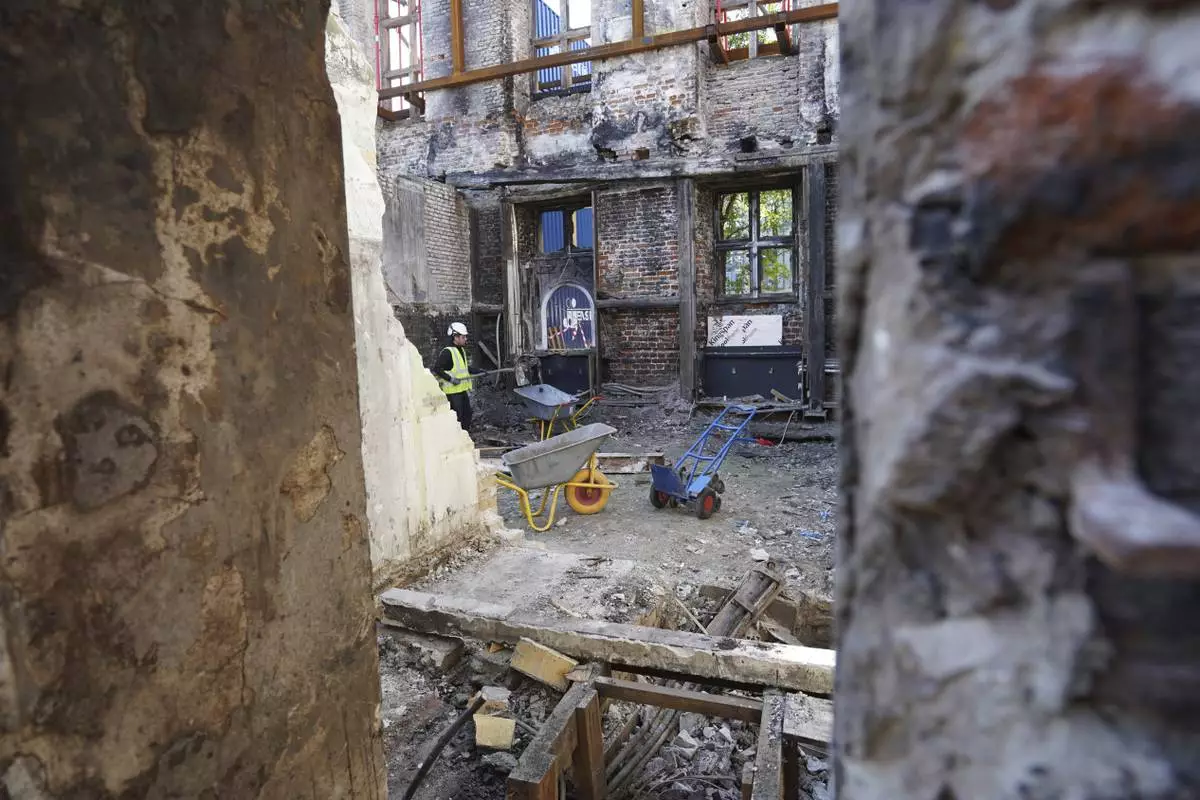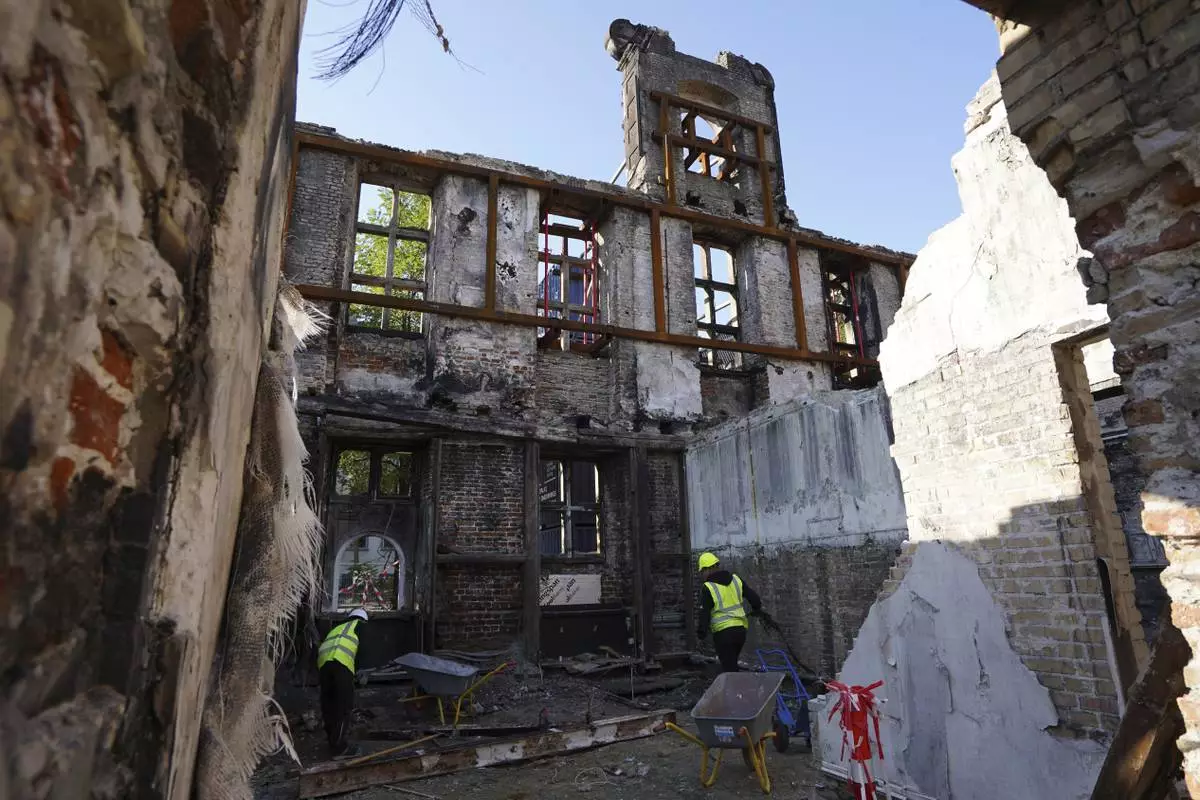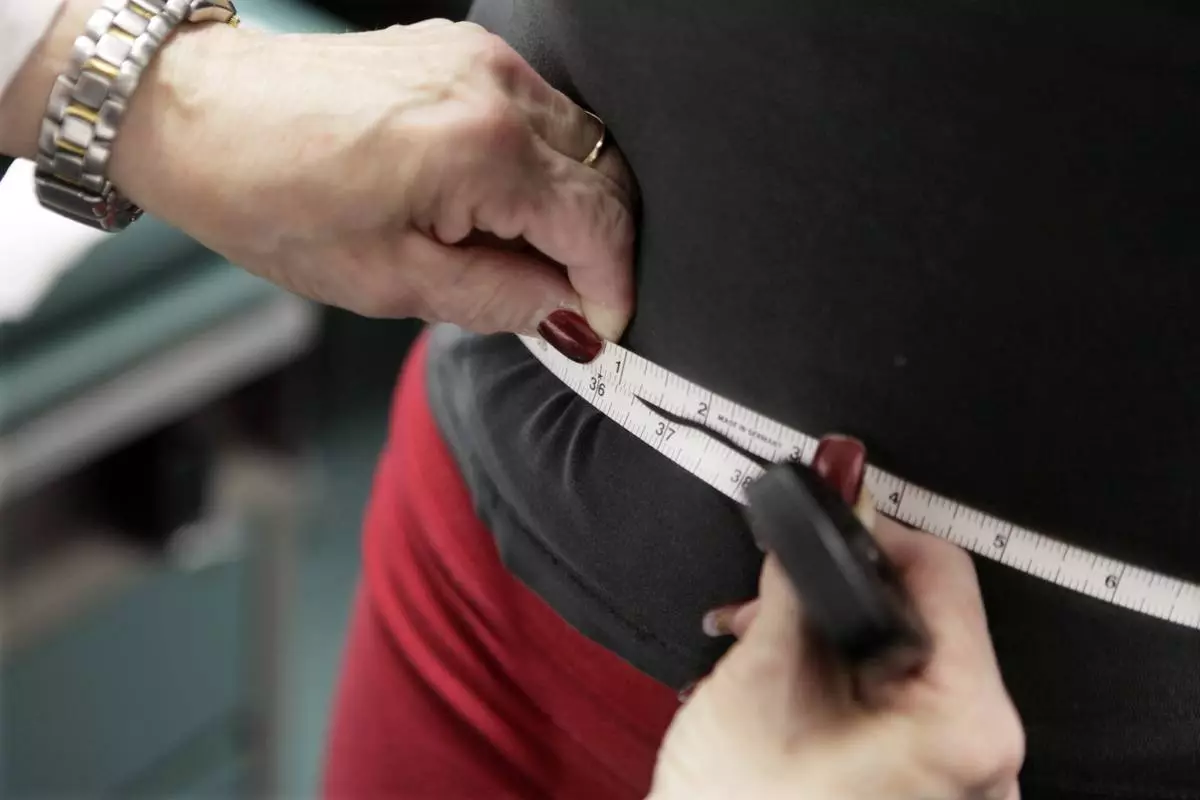COPENHAGEN, Denmark (AP) — Five months after a devastating fire destroyed more than half of Copenhagen’s Old Stock Exchange, workers are set to begin the reconstruction of the 400-year-old building to return it to its former glory.
On Thursday, King Frederik X of Denmark will lay a “foundation stone” within part of a red brick wall that survived the mid-April blaze, commencing a yearslong reconstruction plan.
Click to Gallery
COPENHAGEN, Denmark (AP) — Five months after a devastating fire destroyed more than half of Copenhagen’s Old Stock Exchange, workers are set to begin the reconstruction of the 400-year-old building to return it to its former glory.
Lars Daugaard Jepsen, head of reconstruction at Denmark's Chamber of Commerce, peers through a window at Copenhagen's Old Stock Exchange building in Copenhagen, Denmark, Thursday, Sept. 19, 2024. (AP Photo James Brooks)
Remains of Copenhagen's Old Stock Exchange building are seen in Copenhagen, Denmark, Thursday, Sept. 19, 2024. (AP Photo James Brooks)
Workers clear rubble at Copenhagen's Old Stock Exchange building in Copenhagen, Denmark, Thursday, Sept. 19, 2024. (AP Photo James Brooks)
Workers clear rubble at Copenhagen's Old Stock Exchange building in Copenhagen, Denmark, Thursday, Sept. 19, 2024. (AP Photo James Brooks)
Remains of Copenhagen's Old Stock Exchange building are seen through a broken glass window in Copenhagen, Denmark, Thursday, Sept. 19, 2024. (AP Photo James Brooks)
“We will do this as fast as possible to have Boersen ready for the Copenhageners, for the Danes, for the world again,” said Lars Daugaard Jepsen, head of reconstruction at Denmark’s Chamber of Commerce, which owns the building. He used the Danish name for the stock exchange building.
On Friday, there will be an open day event where visitors can come and see what is left of the downtown exchange. Construction started in 1615 and first opened in 1624. It is considered a leading example of Dutch Renaissance style in Denmark.
In the early morning of April 16, a violent fire tore through the building, a major tourist attraction. The blaze toppled its green copper roof and iconic dragon-tail spire. Two days later, a large section of the building’s outer wall collapsed inwards.
As the fire raged, many, including ordinary people, ventured in to rescue artworks and around 90% of the cultural objects were rescued from the fire.
Authorities have yet to reveal the cause of the fire, but it's believed to have started on the building’s roof, which had been wrapped in scaffolding because of ongoing renovation work to be completed for its anniversary in 2024.
Instead of a renovated building, it's now a ruin.
But there are detailed records of its design.
“We have a lot of pictures, we have a lot of papers, we have a lot of knowledge about this building,” Daugaard Jepsen told The Associated Press, during a recent site tour. “That’s also why we are very optimistic of rebuilding this place.”
He said they want to use the same materials that were available in the construction 400 years ago.
Before the fire, the chamber of commerce had ordered 80,000 bricks — handmade in Germany and burnt in coal-fired ovens — for renovation work. That order has now increased to 800,000.
The wood used in the 17th century came from a Swedish Baltic Sea island and was already 160 years old when brought to Denmark, Daugaard Jepsen said.
“We are looking for about 800 to 1,000 trees on Gotland, because we will use the same materials,” he said.
Since April, workers have cleared more than 1,000 tons of debris after the fire, which was reminiscent of the April 2019 blaze at the 800-year-old old Notre Dame Cathedral in Paris.
But the new construction won’t be exactly as before, Daugaard Jepsen said, adding the interior has changed eight times during its history and will take on a new appearance again.
“Our task is to look forward,” he said. The aim is “to make a building that will stand for at least 400 years.”
The reconstruction cost and a date for when it is expected to be completed have yet to be revealed. But Daugaard Jepsen said the five years it took to rebuild Notre Dame is a “very good guess.”
“We will do it as fast as we can,” he said with a smile.
AP journalist Jan M. Olsen contributed to this report.

A window, blackened with soot, is seen at Copenhagen's Old Stock Exchange building in Copenhagen, Denmark, Thursday, Sept. 19, 2024. (AP Photo James Brooks)

Lars Daugaard Jepsen, head of reconstruction at Denmark's Chamber of Commerce, peers through a window at Copenhagen's Old Stock Exchange building in Copenhagen, Denmark, Thursday, Sept. 19, 2024. (AP Photo James Brooks)

Remains of Copenhagen's Old Stock Exchange building are seen in Copenhagen, Denmark, Thursday, Sept. 19, 2024. (AP Photo James Brooks)

Workers clear rubble at Copenhagen's Old Stock Exchange building in Copenhagen, Denmark, Thursday, Sept. 19, 2024. (AP Photo James Brooks)

Workers clear rubble at Copenhagen's Old Stock Exchange building in Copenhagen, Denmark, Thursday, Sept. 19, 2024. (AP Photo James Brooks)

Remains of Copenhagen's Old Stock Exchange building are seen through a broken glass window in Copenhagen, Denmark, Thursday, Sept. 19, 2024. (AP Photo James Brooks)
Obesity is high and holding steady in the U.S., but the proportion of those with severe obesity — especially women — has climbed since a decade ago, according to new government research.
The U.S. obesity rate is about 40%, according to a 2021-2023 survey of about 6,000 people. Nearly 1 in 10 of those surveyed reported severe obesity, the U.S. Centers for Disease Control and Prevention found. Women were nearly twice as likely as men to report severe obesity.
The overall obesity rate appeared to tick down vs. the 2017-2020 survey, but the change wasn’t considered statistically significant; the numbers are small enough that there’s mathematical chance they didn’t truly decline.
That means it’s too soon to know whether new treatments for obesity, including blockbuster weight-loss drugs such as Wegovy and Zepbound, can help ease the epidemic of the chronic disease linked to a host of health problems, according to Dr. Samuel Emmerich, the CDC public health officer who led the latest study.
“We simply can’t see down to that detailed level to prescription medication use and compare that to changes in obesity prevalence,” Emmerich said. “Hopefully that is something we can see in the future.”
Most telling though, the results that show that the overall obesity rate in the U.S. has not changed significantly in a decade, even as the rate of severe obesity climbed from nearly 8% in the 2013-2014 survey to nearly 10% in the most recent one. Before that, obesity had increased rapidly in the U.S. since the 1990s, federal surveys showed.
Measures of obesity and severe obesity are determined according to body mass index, a calculation based on height and weight. People with a BMI of 30 are considered to have obesity; those with a BMI of 40 or higher have severe obesity. BMI is regarded as a flawed tool but remains widely used by doctors to screen for obesity.
“Seeing increases in severe obesity is even more alarming because that’s the level of obesity that’s most highly associated with some of the highest levels of cardiovascular disease and diabetes and lower quality of life,” said Solveig Cunningham, an Emory University global health professor who specializes in obesity.
Cunningham, who was not involved in the new study, said it’s not clear why rates of severe obesity are going up, or why they were higher among women. Factors could include the effects of hormones, the impact of childbearing or other causes that require further study, she said.
The new study also found that obesity rates varied by education. Almost 32% of people with a bachelor’s degree or higher reported having obesity, compared with about 45% of those with some college or a high school diploma or less.
The new report follows the release earlier this month of data from U.S. states and territories that showed that in 2023, the rate of obesity ranged widely by place, from a high of more than 41% of adults in West Virginia to a low of less than 24% of adults in Washington, D.C. Rates were highest in the Midwest and the South.
All U.S. states and territories posted obesity rates higher than 20%. In 23 states, more than 1 in 3 adults had obesity, the data showed. Before 2013, no state had a rate that high, said Dr. Alyson Goodman, who leads a CDC team focused on population health.
Color-coded U.S. maps tracking the change have gradually shifted from green and yellow, the hues associated with lower obesity rates, to orange and dark red, linked to higher prevalence.
“Sometimes, when you look at all that red, it’s really discouraging,” Goodman said.
But, she added, recent emphasis on understanding obesity as a metabolic disease and new interventions, such as the new class of weight-loss drugs, gives her hope.
The key is preventing obesity in the first place, starting in early childhood, Cunningham said. Even when people develop obesity, preventing additional weight gain should be the goal.
“It’s really hard to get obesity to reverse at the individual level and at the population level,” Cunningham said. “I guess it’s not surprising that we’re not seeing downward shifts in the prevalence of obesity.”
The Associated Press Health and Science Department receives support from the Howard Hughes Medical Institute’s Science and Educational Media Group. The AP is solely responsible for all content.

FILE - This file photo shows a closeup of a beam scale in New York, April 3, 2018. (AP Photo/Patrick Sison, File)

FILE - A subject's waist is measured during an obesity prevention study in Chicago on Jan. 20, 2010. (AP Photo/M. Spencer Green, File)























